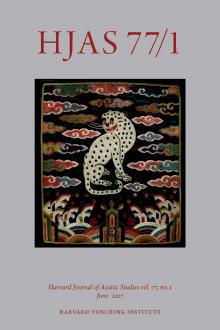June 2017
Details: Artist unknown, Korean; Chosŏn dynasty, 19th century. Rank badge with white leopard decoration; polychrome silk-floss embroidery in satin stitch on a dark blue silk damask ground with gold thread border: H. 21.5 × W. 18.8 cm (87∕16 × 7⅜ in.). Harvard University Art Museums/Arthur M. Sackler Museum, Gift of Marilyn and Robert Hamburger, 2002.254. Photo: Imaging Department ©President and Fellows of Harvard College.
Editorial Preface
Articles
Special Issue: The Tributary System
Long Live the Tributary System!
The Future of Studying East Asian Foreign Relations
Collective Imaginations and International Order
The Contemporary Context of the Chinese Tributary System
A large body of scholarship in Political Science suggests that the material power of a dominant state is critical for the stabilization of international order. Consequently, the relative decline of the United States and the ascendance of China raise concerns regarding the stability of the current international system. By contrast, culturalist accounts such as David Kang’s East Asia before the West submit that a stable order can be based on a shared cultural framework rather than material force. Despite their many contributions, the methodological design of such analyses—Kang’s included—do not allow us to attribute Chinese hegemony in the tributary system primarily to cultural factors. Examining the salience of cultural factors for international order requires a different research design that incorporates greater variation across history and regions and that recognizes the multivocality of imperial claims to authority.
物质力量对于国际秩序所起的重要作用引发人们对中国崛起的关注。康灿雄等的文化主义论述则认为秩序可建基于共享的文化观,但其研究方法却无法解释朝贡体系里文化因素的作用。因此,探讨文化对国际秩序的影响时,既要作跨历史、跨区域的比较研究,又要考察帝国权威的多义性。
Me, Myself, and My Hegemony
The Work of Making the Chinese World Order a Reality
This article explores a puzzle at the heart of the tributary system, an early modern East Asian system of international relations: What exactly did China get out of it? I argue that Chinese participation in the tributary system engendered domestic legitimacy. The tributary system produced substantive benefits domestically for China but little power internationally. In fact, the assumption that the tributary system functioned primarily as a vehicle for Chinese regional domination is a modernist artifact. That coherence, not coercion, characterized a more flexible East Asian tributary system is difficult to see from a modern international relations (IR) perspective. Within Westphalian IR, the arc of hegemony bends toward domination because sovereignty requires egalitarian relations; conversely, hierarchical relations diminish autonomy and self-determination. This article offers a different East Asian genealogy of hegemony.
이른바 中華世界秩序의 構築과 强制를 동아시아에서 共有하는 漢字儒教 文化에서 찾는 기존연구와 달리, 본문은 中國의 觀點에서 朝貢體制의 이점을 檢討하고 朝貢體制를 통해 얻을 수 있는 國際的 利益은 미미하였으나, 國內的으로 正當性을 强化시킬 수 있는 기제가 되었다고 주장한다.
The Tributary System and the Persistence of Late Victorian Knowledge
In his 1968 edited volume, The Chinese World Order, John K. Fairbank famously presents his “preliminary framework” for a Ming–Qing tributary system. The recent rehabilitation of the tributary system in International Relations scholarship is surprising because debates over the concept ultimately judged a tributary-system model deeply problematic. I therefore ask: (1) Can we speak of states as ontologically stable entities over centuries? (2) How might we distinguish a totalizing tributary system from tributary practice in order to allow for a diversity of context? (3) If we return to the tributary system as the lens through which we understand “China,” what elisions must we thus tolerate? Ultimately, the current manifestation of the tributary system is not an innovation but rather a return to an older school of nineteenth-century China-watching.
본문은 최근 조공체제의 재조명이 19 세기 중국을 관찰하는 옛 방식으로 회귀한다고 주장하고 세가지 의문을 제시한다. 국가를 수세기에 걸친 불변의 존재로 볼 수 있는가? 조공체제와 조공 관례를 어떻게 구분할 것인가? 조공체제를 중국을 이해하는 렌즈로 삼으면 무엇을 간과하게 될 것인가?
China is China, Not the Non-West
David Kang, Eurocentrism, and Global Politics
David Kang’s explanation for the peace and stability in East Asia that continued from the fourteenth to nineteenth centuries positions itself against mainstream understandings of world order in the field of International Relations, which derive exclusively from the experience of the West. However, Kang’s own explanations and theories remain worryingly Eurocentric and are profoundly mimetic of the very approaches he seeks to go beyond. The implications of this Eurocentrism for epistemic and physical violence against ethnic minorities, indigenous peoples, and various others in border-zone areas—in both the West and the East—are dire and merit explicit attention.
康灿雄对 14 世纪至 19 世纪东亚的和平与稳定所作的阐释对国际关系学中有关世界秩序的主流认识提出了挑战,但是,深入分析可以看出,康灿雄的解释和理论仍摆脱不了他试图超越的欧洲中心论。这种欧洲中心论意味着对少数族裔、土著民和边疆地区不同人种的侵犯。这种可悲的现象值得关注。
